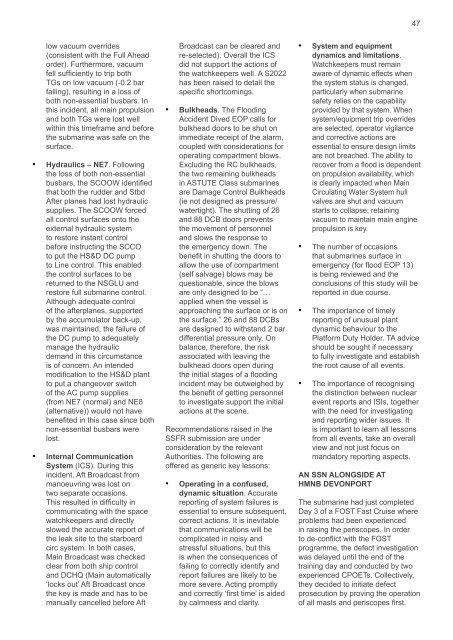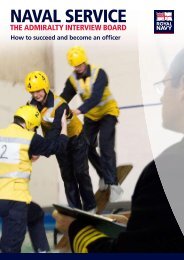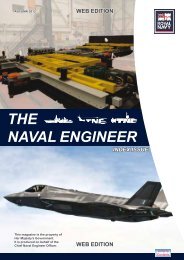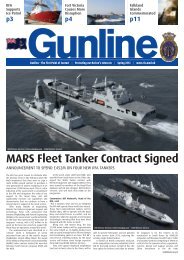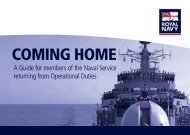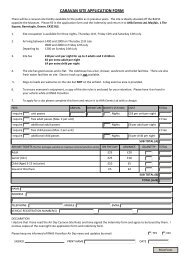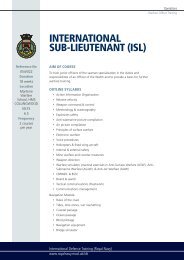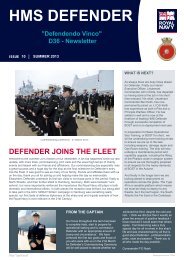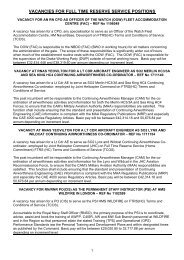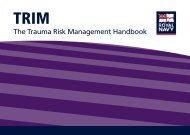THE NAVAL ENGINEER
THE NAVAL ENGINEER
THE NAVAL ENGINEER
You also want an ePaper? Increase the reach of your titles
YUMPU automatically turns print PDFs into web optimized ePapers that Google loves.
47<br />
low vacuum overrides<br />
(consistent with the Full Ahead<br />
order). Furthermore, vacuum<br />
fell sufficiently to trip both<br />
TGs on low vacuum (-0.2 bar<br />
falling), resulting in a loss of<br />
both non-essential busbars. In<br />
this incident, all main propulsion<br />
and both TGs were lost well<br />
within this timeframe and before<br />
the submarine was safe on the<br />
surface.<br />
• Hydraulics – NE7. Following<br />
the loss of both non-essential<br />
busbars, the SCOOW identified<br />
that both the rudder and Stbd<br />
After planes had lost hydraulic<br />
supplies. The SCOOW forced<br />
all control surfaces onto the<br />
external hydraulic system<br />
to restore instant control<br />
before instructing the SCCO<br />
to put the HS&D DC pump<br />
to Line control. This enabled<br />
the control surfaces to be<br />
returned to the NSGLU and<br />
restore full submarine control.<br />
Although adequate control<br />
of the afterplanes, supported<br />
by the accumulator back-up,<br />
was maintained, the failure of<br />
the DC pump to adequately<br />
manage the hydraulic<br />
demand in this circumstance<br />
is of concern. An intended<br />
modification to the HS&D plant<br />
to put a changeover switch<br />
of the AC pump supplies<br />
(from NE7 (normal) and NE8<br />
(alternative)) would not have<br />
benefited in this case since both<br />
non-essential busbars were<br />
lost.<br />
• Internal Communication<br />
System (ICS). During this<br />
incident, Aft Broadcast from<br />
manoeuvring was lost on<br />
two separate occasions.<br />
This resulted in difficulty in<br />
communicating with the space<br />
watchkeepers and directly<br />
slowed the accurate report of<br />
the leak site to the starboard<br />
circ system. In both cases,<br />
Main Broadcast was checked<br />
clear from both ship control<br />
and DCHQ (Main automatically<br />
‘locks out’ Aft Broadcast once<br />
the key is made and has to be<br />
manually cancelled before Aft<br />
Broadcast can be cleared and<br />
re-selected). Overall the ICS<br />
did not support the actions of<br />
the watchkeepers well. A S2022<br />
has been raised to detail the<br />
specific shortcomings.<br />
• Bulkheads. The Flooding<br />
Accident Dived EOP calls for<br />
bulkhead doors to be shut on<br />
immediate receipt of the alarm,<br />
coupled with considerations for<br />
operating compartment blows.<br />
Excluding the RC bulkheads,<br />
the two remaining bulkheads<br />
in ASTUTE Class submarines<br />
are Damage Control Bulkheads<br />
(ie not designed as pressure/<br />
watertight). The shutting of 26<br />
and 88 DCB doors prevents<br />
the movement of personnel<br />
and slows the response to<br />
the emergency down. The<br />
benefit in shutting the doors to<br />
allow the use of compartment<br />
(self salvage) blows may be<br />
questionable, since the blows<br />
are only designed to be “…<br />
applied when the vessel is<br />
approaching the surface or is on<br />
the surface.” 26 and 88 DCBs<br />
are designed to withstand 2 bar<br />
differential pressure only. On<br />
balance, therefore, the risk<br />
associated with leaving the<br />
bulkhead doors open during<br />
the initial stages of a flooding<br />
incident may be outweighed by<br />
the benefit of getting personnel<br />
to investigate support the initial<br />
actions at the scene.<br />
Recommendations raised in the<br />
SSFR submission are under<br />
consideration by the relevant<br />
Authorities. The following are<br />
offered as generic key lessons:<br />
• Operating in a confused,<br />
dynamic situation. Accurate<br />
reporting of system failures is<br />
essential to ensure subsequent,<br />
correct actions. It is inevitable<br />
that communications will be<br />
complicated in noisy and<br />
stressful situations, but this<br />
is when the consequences of<br />
failing to correctly identify and<br />
report failures are likely to be<br />
more severe. Acting promptly<br />
and correctly ‘first time’ is aided<br />
by calmness and clarity.<br />
• System and equipment<br />
dynamics and limitations.<br />
Watchkeepers must remain<br />
aware of dynamic effects when<br />
the system status is changed,<br />
particularly when submarine<br />
safety relies on the capability<br />
provided by that system. When<br />
system/equipment trip overrides<br />
are selected, operator vigilance<br />
and corrective actions are<br />
essential to ensure design limits<br />
are not breached. The ability to<br />
recover from a flood is dependent<br />
on propulsion availability, which<br />
is clearly impacted when Main<br />
Circulating Water System hull<br />
valves are shut and vacuum<br />
starts to collapse; retaining<br />
vacuum to maintain main engine<br />
propulsion is key.<br />
• The number of occasions<br />
that submarines surface in<br />
emergency (for flood EOP 13)<br />
is being reviewed and the<br />
conclusions of this study will be<br />
reported in due course.<br />
• The importance of timely<br />
reporting of unusual plant<br />
dynamic behaviour to the<br />
Platform Duty Holder. TA advice<br />
should be sought if necessary<br />
to fully investigate and establish<br />
the root cause of all events.<br />
• The importance of recognising<br />
the distinction between nuclear<br />
event reports and ISIs, together<br />
with the need for investigating<br />
and reporting wider issues. It<br />
is important to learn all lessons<br />
from all events, take an overall<br />
view and not just focus on<br />
mandatory reporting aspects.<br />
An SSN alongside at<br />
HMNB Devonport<br />
The submarine had just completed<br />
Day 3 of a FOST Fast Cruise where<br />
problems had been experienced<br />
in raising the periscopes. In order<br />
to de-conflict with the FOST<br />
programme, the defect investigation<br />
was delayed until the end of the<br />
training day and conducted by two<br />
experienced CPOETs. Collectively,<br />
they decided to initiate defect<br />
prosecution by proving the operation<br />
of all masts and periscopes first.


